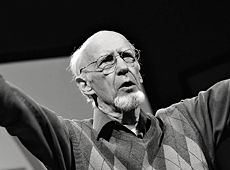by George Patterson
Our Lord sends us to disciple every “nation” (people group) by training them to obey all His commands (Matt 28:18-20). This means that we disciple a “nation” only when it is permeated by obedient disciples who also disciple other unevangelized peoples. So we don’t fulfill the mandate by simply starting one missional community amidst a people.
We, or those we send, must start the kind of missional community that grows and reproduces spontaneously as missional communities will, in daughter missional communities, granddaughter missional communities, great-granddaughter missional communities and so on. Spontaneous reproduction of missional communities means the Holy Spirit moves a missional community to reproduce daughter missional communities on its own, without outsiders pushing it (Acts 13:1-3).
I began training pastors in Honduras in a traditional theological institution and had the traditional problems for the traditional reasons. I assumed the bright young men I trained were dedicated because they came to our resident Bible school. Our plan was for them to return to their home towns as pastors.
But the graduates found the gold lettering on their diplomas did not go well with the white-washed adobe walls back home. It enabled them, however, to earn more in the office of the Dole Banana Co. My raspy supervisor had the gall to blame us teachers; he told us, “Close the school; start discipling the people.”
“No,” I argued, “that’s too hard.”
“Excuses! They’re poor, semi-literate, subsistence farmers but you teach as though they were educated, middle class
Americans.”
I wrote my missionary buddies from language school, now spread all over Latin America, fishing for sympathy. They had the same problem!
“I’m a teacher without a classroom!” I complained.
“So,” my supervisor rasped, “teach by extension.”
“What’s that?”
He handed me a smelly old saddle, explaining, “You’re promoted. This is the Chair of Evangelism and Church Planting in your new extension Bible institute.”
After a few weeks of blisters on my south side I learned to communicate with the mission mule and announced, “Hey, I can do this TEE stuff. It’s great.”
My supervisor warned me, “Then your students had better raise up and pastor their own churches or we’ll close down this Theological Education by Extension, too.”
I took the pastoral studies to family men (Biblical “elder” types) in the poverty-ridden villages, mountains and cities. Unlike their single young sons, they had crops, jobs or family responsibilities that kept them from going off to our resident Bible school. They also lacked the education to absorb its intensive teaching. But these older men, with roots in their villages and barrios, could begin pastoring with the respect of their people easier than the single young men could. By God’s mercy I slowly learned to evangelize and disciple these elders in a way that enabled them to raise up and pastor their small village churches.
As will be the case in many of today’s remaining unreached fields, we began to see growth not through any one church growing big or fast, but through the slow, steady reproduction of many small churches. I could have avoided years of struggle searching for principles of church reproduction had I looked first in the operator’s manual.
New Testament discipling principles, conscientiously applied, are enabling churches to reproduce in Honduras and many other fields. Field testing of programs based on these principles give consistently good results in Latin America and Asia, including hostile fields where evangelism is illegal.
We must distinguish between these general principles and culture-specific applications.
We must distinguish between these general principles and culture-specific applications. Biblical principles themselves, if applied with culturally relevant methods, should enable churches to reproduce wherever there is plenty of “good soil.” Theologically speaking, good soil for the gospel seed to take root in and multiply is bad people, and lots of them (Rom 5:20-21; Matt 13:18:23; Eph 2:1-10).
The simplicity of the principles disappoints some educators. They expect something more sophisticated, at least new or expensive. Missionary or not, one can multiply disciples doing these four simple things:
- Know and love the people you disciple.
- Mobilize your disciples to edify immediately those they are discipling.
- Teach and practice obedience to Jesus’ basic commands, in love, before and above all else.
- Build loving, edifying accountability relationships between disciples and churches in order to reproduce churches.
1. Know And Love the People You Disciple
We must know and love a people before we can disciple them. When Jesus told His disciples to “Look at the fields,” they were finding it hard to love the Samaritans around them; they could not see them receiving God’s grace.
Limit Your Area of Responsibility to One People or Community
We must focus on one people group, the one God has given us. Paul knew his area of responsibility before God (2 Cor 10:12-16; Acts 16:6-10; Gal 2:8). He knew what kind of churches to plant and where. For a movement of church reproduction a church planting team needs a clear focus from God. My area was “the Spanish speaking people of the Aguan Valley and surrounding mountains.” It helps to be exact.
At home or abroad every discipler needs to ask: “For whom am I responsible?” If a missionary fails to do this, the geographic and ethnic limits of his ministry remain blurred. He will jump from opportunity to opportunity. I asked one of these wandering gold prospectors in Central America what his area of responsibility was. “Oh,” he said, “I am winning the country for Christ.” He goes from city to city preaching in prisons and army camps; he bombs villages with tracts from his Cessna.
It’s fun and folks back home eagerly finance it. But he will never plant a reproductive church until he learns to hold the people of a community in his heart. Choosing your people in a new field needs study and prayer. Confer with other missionaries, nationals and God Himself for guidance.
Knowing a people means touching the heart of individuals. Laughing with those who laugh. Weeping with those who weep. Playing marbles with 2-year old Chimbo and checkers with his grandpa (or whatever they play in the town square). It may help if you let him beat you. This applies to arguing religion, too. It’s dangerous always to be “right” when you’re the new kid on the block. Learn to appreciate the people and their ways, even the toothless old men. Listen and learn until you have discovered those things in their folk religion or culture that help communicate the gospel.
Once you know your area and people, discern which segment among them is most receptive to you and to Jesus Christ. To penetrate restricted, resistant fields, aim first at the working class or an oppressed minority. This contradicts some popular church growth theories. We are not dealing with second generation growth in Pasadena, California, however, but the initial beachhead where people get a curved blade in their ribs for witnessing.
Jesus did not begin His public ministry among the influential middle class and natural leaders in the political nerve centers of Rome or Jerusalem, but with the working class upriver in Galilee where they spoke Hebrew with a backwoods accent—otherwise He would have been crucified prematurely.
Let the Church Be of the People
Like most inexperienced church planters I started “preaching points” at first, instead of genuine New Testament churches. Someone went every week to a community where a group gathered to hear their pulpit oratory and sing (well, at least to sing). Converts were not baptized. Local leaders were not trained. The Lord’s Supper was neglected. No one knew for sure who were Christians. Obedient, sacrificial discipling gave way to entertaining (a tradition brought by American missionaries).
Preaching points develop a personality of their own; they stubbornly refuse to evolve into obedient, giving, reproductive churches. They become sponges soaking up the time and efforts of outside workers and producing nothing—except where God’s sheer mercy overrides our routine.
Find what a church’s people can do and plan that, before planning its structure, forms and organization. I hope it takes you less time than it took me to learn that formal pulpit preaching is ineffective (often illegal) in many of today’s remaining unreached fields. You can preach the Word with power in many other ways, if you know your people. We used dramatic Bible reading, songs with music and lyrics composed by nationals, poems, symbols and story telling. They sang with more enthusiasm when they composed songs in the local style.
Let the new church’s self-identity be evident. Know exactly what you are aiming at within the community: a well defined body of obedient disciples of Jesus Christ. Once I made the mistake of allowing more outside helpers to be present than members of the community during the first baptism and celebration of the Lord’s Supper. The church died at birth. There must be a majority from the community itself, especially at the first baptism or worship meetings, or the church is not born as a distinct entity within the community.
Our converts felt that they had simply been added to some organization of the outsiders. I robbed them of the thrill of looking at each other and saying, “We are now the church here!” They must see the new church being born as a part of their community.
List What You Will Do to Reproduce Disciples Among a People
Let’s assume you research well all the factors: race, culture, logistics, urban versus rural backgrounds, language similarities, education and economic levels, etc. You learn the language. Then you go in a crowded bus to your new field, with a team of church planters as similar to the local people as possible in every aspect. Some or all of them may be from another developing country. You are happy because they do not have to make that long cultural leap that delays church planting by years (the less responsive the people are to missionaries, the more crucial this cultural fit). Now you finally arrive, unpack your toothbrush, take a deep breath, pray, step out the door and find fifty thousand people living around you who think Jesus was John Wayne’s cousin.
Now what?
What you do first often determines the direction of your work, for good or bad, for years to come. Will it lead to reproductive churches? The right steps will vary for each field but will always include teaching the converts first to obey Jesus’ basic commands (Matt 28:18-20). Take the shortest route possible to start a real church: a group of believers in Christ dedicated to obey His commands. In a pioneer field let it start small, perhaps with only three or four members. It will grow if you disciple the people as Jesus said.
Avoid institutions if possible at this beachhead stage (community development programs unrelated to church planting, clinics, etc.). It’s best to let these come later. In Honduras we developed community development work but it grew out of the churches, not vice versa. We taught obedience to the great commandment of loving our neighbor in a practical way. A poverty program can aid church planting if the two are integrated by the Holy Spirit. But churches dependent on charitable institutions are almost always dominated by the foreign missionary and seldom reproduce.
6 Sure-Fire Principles for Multiplying Your Group From the Harvest
To start a group, missional community, or church that will multiply in the normal way in a pioneer field with no experienced pastors nor organized churches, take the following steps (change them where local circumstances require it):
1. Witness first to male heads of households. We often told them Bible stories they could pass on immediately, even before being saved, to their own family and friends. We went with them to show them how. But why male heads of families? We worked in a macho culture (right where the word macho came from, where men carried sharpened machetes and used them readily). Female leadership, right or wrong, limited the outreach of brand new works. Later, when a church was established with male pastor and elders, women could take a higher profile. Be sensitive to your community’s norms, especially in the first impressions you give of the church.
2. Baptize all repentant believers without delay (entire families when possible). At first I acted as though a big buzzard were perched on my shoulder just waiting to pounce on our converts that fell away; I delayed baptism to make sure they were “safe.” But I soon saw that the very reason many fell away was my distrust. That’s the funny thing about God’s grace; He wants us to let it slop over on the unworthy (Rom 5:20-21).
3. Provide a style of worship that new elders-in-training can lead and teach to others. Don’t invite the public until local leaders can lead the services. Celebrate the Lord’s Supper weekly as the center of worship, especially until local men are mature enough to preach in an edifying, humble way.
4. Organize a provisional board of elders as soon as mature men are converted. Show them how to win and pastor their own people right away. Remember, this is for pioneer fields with no experienced pastors nor well organized churches. We, like Paul, must use the best men God gives us as the churches multiply, or the new disciples have no leadership at all (Acts 14:23).
5. Enroll these new elders in pastoral training on the job. Don’t remove them from their people for training. Meet with them every two or three weeks (more often if possible) until they are mobilized.
6. Provide a list of activities planned for the congregation, starting with the commands of Christ and His apostles. Let everyone know where he is going and what he needs to learn for each activity. Use this as a check list to monitor the progress of the elders you train, in both their studies and pastoral work, as they mobilize their own people in ministry.
This is part of a 4-part Series by George Patterson called 4 Practical Ways To Multiply Disciples:
Part 2 | Part 3 | Part 4
 George Patterson spent 21 years in Central America training pastors in a way that multiplies churches. George’s strategies and materials for church multiplication have became known and used worldwide. He mentors workers who seriously want to follow New Testament guidelines to sustain church planting movements, many of whom have made significant breakthroughs. He teaches at Western Seminary and has authored Church Multiplication Guide, Train & Multiply, Paul-Timothyand other training materials. See some of his work on MentorAndMultiply.com.
George Patterson spent 21 years in Central America training pastors in a way that multiplies churches. George’s strategies and materials for church multiplication have became known and used worldwide. He mentors workers who seriously want to follow New Testament guidelines to sustain church planting movements, many of whom have made significant breakthroughs. He teaches at Western Seminary and has authored Church Multiplication Guide, Train & Multiply, Paul-Timothyand other training materials. See some of his work on MentorAndMultiply.com.


